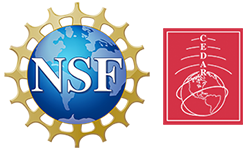2025 Workshop: Meteor, Meteoroid, and Space Debris
Julio Urbina
Nicholas Holl
As meteoroids enter the Earth’s atmosphere, their kinetic energy converts into intense heat, generating a blazing plasma that envelops their form. These plasmas, commonly referred to as meteors, have captivated scientific inquiry for well over a century, yet numerous enigmas persist. Concurrently, the proliferation of space debris—also known as orbital debris, space junk, or space waste—consists of defunct human-made objects orbiting Earth that no longer serve any useful purpose. These artificial meteors and debris, alongside their celestial counterparts, pose enduring hazards to satellite infrastructure, increasing the influx of macroscopic particles into Earth's atmosphere.
To address the outstanding questions currently under investigation in the field of meteor, meteoroid, and debris science and engineering, we invite presentations on the physics of meteoroid and debris particles and their impact on the atmosphere, ionosphere, and satellites.
We welcome presentations exploring engineering methodologies for observing and characterizing meteoroid and debris populations, encompassing various observational techniques such as lidar, radar, satellite-based instruments, and optical methods, as well as modeling approaches.
We also welcome presentations that utilize emerging AI and machine learning techniques to study all types of meteor echoes and space debris,
This is the zoom link for online participation:
https://psu.zoom.us/j/3712177659
The times listed below are approximate.
10:00 - 10:02 AM Welcome and Introduction
10:02 - 10:20 AM Cosmic Particles Hitting the Earth: Evolution of Meteors from Picoseconds to Minutes
by Meers Oppenheim, Yakov Dimant, Alex Green, Trevor Hedges, Alex Fletcher, Gabi Guttormsen, and Sigrid Elschot
10:20 - 10:32 AM Search for Enhanced Scatter from Plasma Waves with Space Objects in Orbit the JRO VHF Radar
by P.A. Bernhardt, B.E. Eliasson, W.A.Scales, and J.D. Huba
10:32 - 10:44 AM Meteor Radar at MIT Haystack: SIMONe and Zephyr Millstone status
by Ryan Volz
10:44 - 10:56 AM Investigating Specular Meteor Radar Performance Using Monte Carlo Simulation
by James Monaco, Scott Palo, and John Marino
10:56 - 11:08 AM 2024-2025 Highlights of radar observations of meteor echoes with multistatic meteorradars and High-Power Large-Aperture Radars
by J. Chau, J. Vierinen, K. Obenberger, and M. Clahsen
11:08 - 11:20 AM Ongoing Meteor Head Echo Surveys on the Northern and Southern Hemispheres
by Juha Vierinen, Daniel Kastinen ,Toralf Renkwitz, Johan Kero, Taishi Hashimoto, Jorge L. Chau, Ralph Latteck, Hakon Silseth, Masaki Tsutsumi, Kazuhiko Mushiake, and Kaoru Sato
11:20 - 11:32 AM Estimating the Space Debris Density Function using Radar Beam Park Measurements
by Juha Vierinen
11:32 - 11: 44 AM Lidar Discovery of AO and SAO of TINa Layers from the First Na Climatology of 75–150 km
by Yingfei Chen and Xinzhao Chu
11:44 - 11: 56 AM Update and Extension of CONDOR Multi-state Meteor Radar
by Alan Liu
11:56 - noon Discussion and Adjourn
These plasmas, commonly referred to as meteors, have been studied for well over a century, yet many outstanding questions remain. Additionally, space debris—also known as orbital debris, space junk, or space waste—consists of human-made objects orbiting Earth that no longer serve any useful purpose. These artificial meteors and meteoroids of astronomical origin pose a long-standing threat to satellites, contributing to the influx of macroscopic particles into Earth's atmosphere.
Several recent networks of multi-static meteor radars, regional radar systems, and optical instruments have received funding. Moreover, ongoing efforts worldwide aim to develop lower-cost radar systems, facilitating new research and discovery and training both undergraduate and graduate students in space science research. Furthermore, the utilization of AI and machine learning in meteor and space debris research has the potential to open new frontiers in space science.
